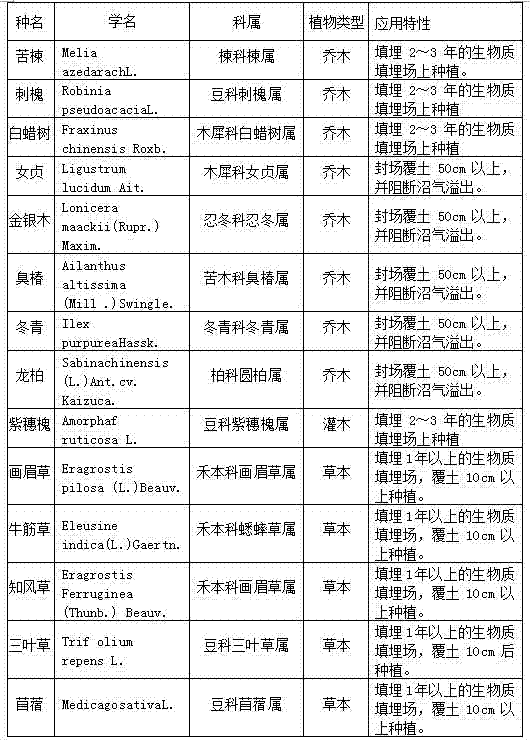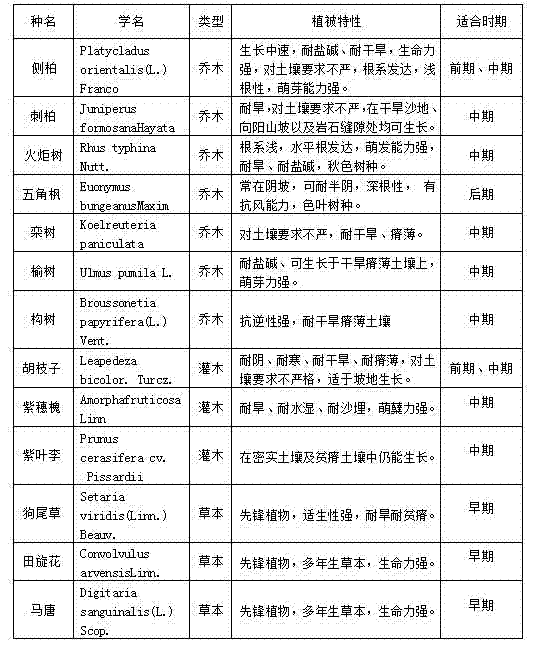Revegetation method for biomass landfill
A technology for vegetation restoration and landfill, which is applied in the field of greening to achieve the effects of improving soil utilization, reducing adverse effects, and reducing engineering workload and investment.
- Summary
- Abstract
- Description
- Claims
- Application Information
AI Technical Summary
Problems solved by technology
Method used
Image
Examples
Embodiment 1
[0030] Described biomass landfill vegetation restoration method comprises the steps:
[0031] (1) Planting soil preparation:
[0032] The soil around the landfill should be crushed after removal of sand and gravel, passed through a 1-3 mesh screen, and then burned together with plant branches, weeds, and crop straw. After being smoked and baked, the soil structure and fertility will be improved, forming Peat soil. Common soil, peat soil and decomposed organic matter around the landfill are mixed evenly at a ratio of 3-5:1-2:1 to form planting soil.
[0033] (2) After the biomass landfill, cover the common soil more than 10cm. After one year, spread 2-100 cm of planting soil on the covering soil, and sow herbaceous plant seeds such as teff, goosegrass, zhifengcao, clover or alfalfa when the climate is suitable.
[0034] (3) Excavate (20-30) cm × (20-30) cm × (20-30) cm planting holes according to the plant row spacing (2-3) m × (2-3) m, and fill in 10-20 cm Planting soil on...
Embodiment 2
[0036] Described biomass landfill vegetation restoration method comprises the steps:
[0037] (1) Planting soil preparation:
[0038] The soil around the landfill should be crushed after removal of sand and gravel, passed through a 1-3 mesh screen, and then burned together with plant branches, weeds, and crop straw. After being smoked and baked, the soil structure and fertility will be improved, forming Peat soil. Common soil, peat soil and decomposed organic matter around the landfill are mixed evenly at a ratio of 3-5:1-2:1 to form planting soil.
[0039] (2) After the field is closed, trim the biomass surface to form a slope top and slope surface, and then cover with 30-150cm of soil. Combined with covering soil trimming, spread a layer of planting soil with a thickness of 2 to 100 cm on the soil covered by the biomass landfill. Sow the seeds of herbaceous plants such as teff, goosegrass, cypress, clover or alfalfa when the weather is suitable.
[0040] (3) Adopt the no...
PUM
 Login to View More
Login to View More Abstract
Description
Claims
Application Information
 Login to View More
Login to View More - R&D
- Intellectual Property
- Life Sciences
- Materials
- Tech Scout
- Unparalleled Data Quality
- Higher Quality Content
- 60% Fewer Hallucinations
Browse by: Latest US Patents, China's latest patents, Technical Efficacy Thesaurus, Application Domain, Technology Topic, Popular Technical Reports.
© 2025 PatSnap. All rights reserved.Legal|Privacy policy|Modern Slavery Act Transparency Statement|Sitemap|About US| Contact US: help@patsnap.com


